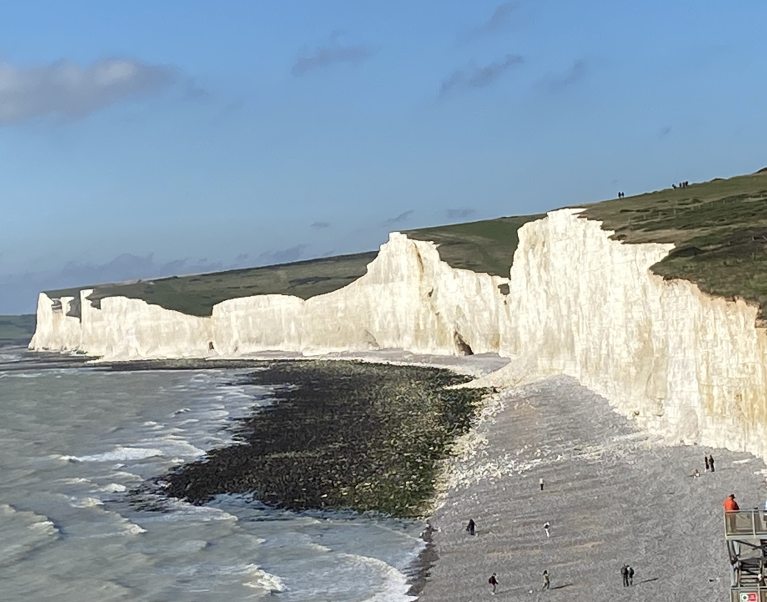1st October, 2025
Following the coastline west from Dover, we pass the Channel Tunnel at Folkestone and the beautiful marshes at Dungeness until we meet Kent’s great friend and rival – Sussex. Perhaps not as well-known as Kent, but just as gorgeous, Sussex really is a hidden gem. The first stop on this journey is the hilltop town of Rye. Sat above the meandering River Rother, Rye was once a look-out spot to defend England from the continent, like Walmer Castle in Kent. Today, it is a sweet little town, with friendly cobbled streets, a decadent chocolate shop named Knoops, and two pubs that are rumoured to be connected by an old smuggling tunnel. Nearby Eastbourne is old-fashioned, but not kitsch, and is well worth a visit for one of its famous ice creams. It also has a claim to being the sunniest town in the UK, though rivals in Kent may take umbrage with this. Here the chalky landscape we saw in Kent re-emerges, and we are greeted by the Seven Sisters, great white cliffs that undulate towards Hampshire, Dorset, and the Jurassic Coast.
The South Downs Way
Turning north, away from the coastline, we come to the stunning South Downs. The Downs are a vast range of chalk hills that stretch all the way west to Winchester, home of Jane Austen. The porous chalk acts like an enormous filter, and so remarkably pure streams well up and support all manner of life. These hills and their bountiful springs have sheltered humans for thousands of years, and at their far southern spur near Chichester once lay the fossilised remains of ‘Boxgrove Man’, a Neanderthal nearly half a million years old.
Many more have joined Boxgrove Man in settling in Sussex, and there are some must-see villages in the Downs. Alfriston, just north of Eastbourne, is home to an elegant medieval high street with some very tasteful shops, like the award winning Much Ado Books and the cute Badger’s Tea House. Just down the road is Charleston, a small country house set up as a haven for artists and conscientious objectors during the First World War. Initially home to the slightly unusual family of Vanessa Bell, her children, Duncan Grant, and his lover David Garnett, it also hosted E.M. Forester and Virginia Woolf. The house and its gardens (designed by Roger Fry to be ‘a living painting’) are now open to the public and are a must-see for art and literature buffs when Sauntering in Sussex!
Seditious Sussex
Though renowned for their rugged beauty, the wild green country of the South Downs is also home to slightly larger towns like Lewes. Lying where the River Ouse (pronounced like ‘ooze’, but much more pleasant) cuts through the chalk, Lewes has quite the tradition of radicalism. Thomas Paine, the revolutionary author of Common Sense and the Rights of Man, lived here for about six years before he emigrated to the Thirteen Colonies. In much of Britain bonfires are lit on the night of 5 November, a tradition that dates back to 1605, and marks the foiled Gunpowder Plot against James VI and I. In Lewes, this gets a bit out of hand: every year, effigies of celebrities and world leaders are set on fire before being paraded past this picturesque town’s cosy coffeeshops and independent boutiques. It should be said that Lewes is actually quite friendly! As well as lighting fires, there is a local practice of letting parts of their garden grow wild, to give the hedgehogs, door mice, and chalkhill blue butterflies of the South Downs plenty of space to live and move about.
Castle and Cathedral
Every county needs at least one good cathedral, and Sussex’s most remarkable monument is probably in the tiny town of Arundel. The story really starts with Arundel Castle, seat of the (confusingly named) Dukes of Norfolk. This title belongs to the Howard family, who were movers and shakers in English politics between the Wars of the Roses and the English Civil War. The most famous Howard is probably Philip Howard, 20th Earl of Arundel, who was martyred by Elizabeth I for refusing to give up his Catholic faith. After Catholic emancipation in the 19th century, Arundel Cathedral was built in imitation of the medieval French Gothic style – which gives this graceful market town a rather distinctive skyline. As well as historic attractions, there are also plenty of independent shops with old-world charm.
And so concludes our whistle-stop tour of the south-east coast! From the bustle of Canterbury to the serenity of Charleston, there is something in Kent and Sussex for everyone (even the Neanderthals!).
Posted by: Will Garbett
Tags: Don't miss, Eat + drink, Hidden gems, History, Insider info, Luxury specials, Walking holidays

